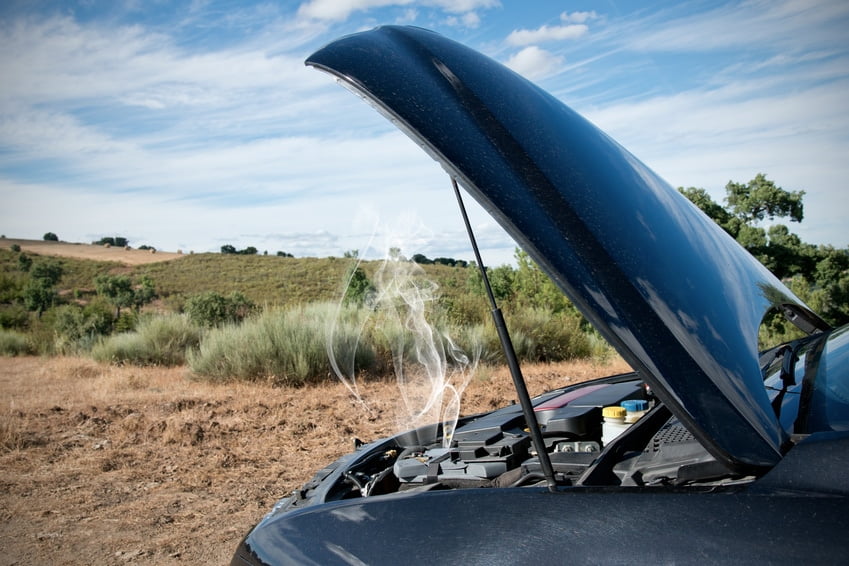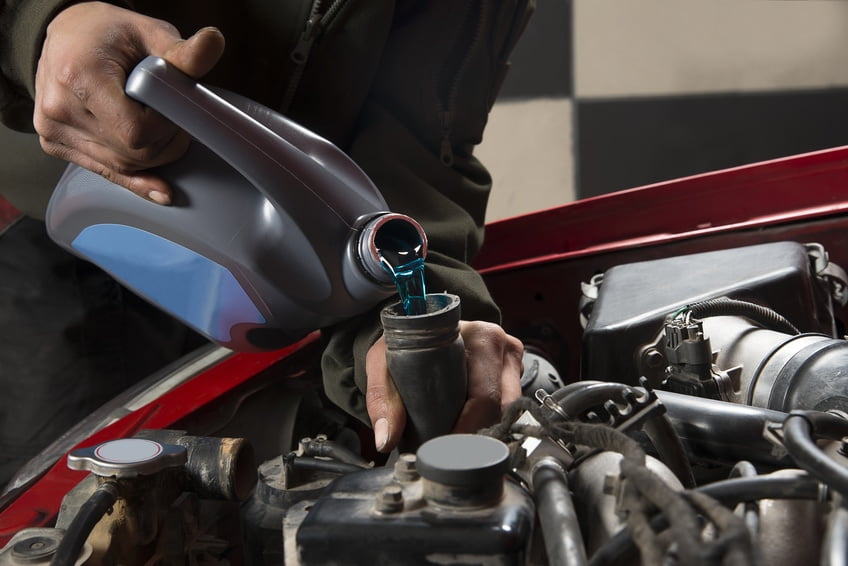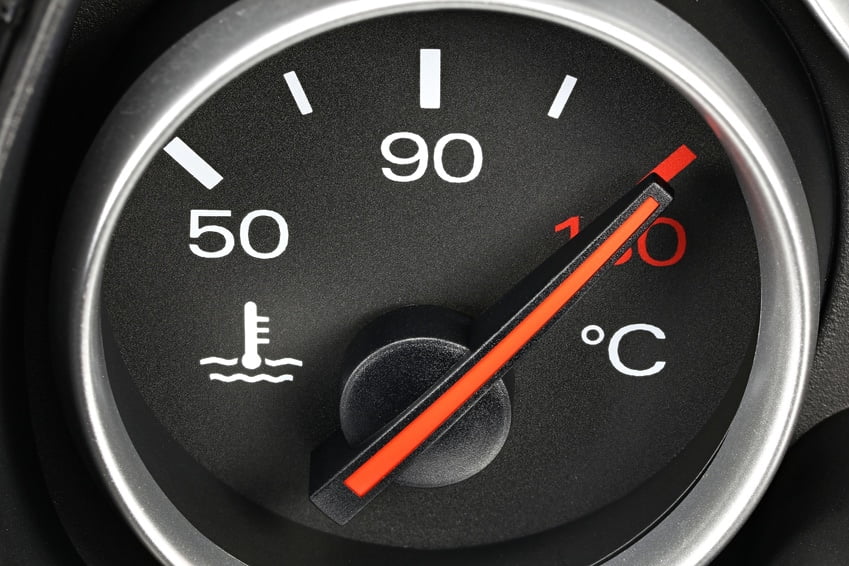Overheating is one of the most common causes of breakdowns on UK roads. It’s a symptom of a fault in the cooling system, either caused by a leak or defective component. A lot of drivers will experience an overheating engine at some point, so it’s important to know how to spot the warning signs, and how best to prevent overheating in the first place.
Of course, an overheating engine isn’t the only way your car can get a little too hot to handle. In summer, car cabins can reach a stifling 40°C, which isn’t pleasant for us drivers, our passengers or our four-legged friends.
Here, we offer a comprehensive guide to preventing and troubleshooting an overheating car, including links to helpful resources that will help you check and top up your car’s coolant/antifreeze reservoir, and tips and tricks on how best to keep your car cool during the summer.
Use the quick links below to skip to the relevant section of our car overheating guide:
- Overheating Prevention Tips
- Symptoms of an Overheating Engine
- What to Do if Your Car Overheats While Driving
- Tips and Tricks on How to Keep Your Car Cool in the summer
Overheating Prevention Tips
The risk of an overheating engine depends on the age and condition of your car, as well the maintenance schedule of the cooling system. If you stick to your car’s recommended servicing schedule and regularly check the level and condition of the coolant/antifreeze, the risk of an overheating engine is significantly reduced.
 Below, we list some top tips and resources which should help prevent an overheating engine.
Below, we list some top tips and resources which should help prevent an overheating engine.
- Check the coolant/antifreeze level regularly – Depending on the amount of travelling you do, we’d recommend checking the coolant/antifreeze level every fortnight to be sure of complete protection. Our guide to checking the level of the cooling system shows you how it’s done.
- Spot the signs of a faulty coolant temperature sensor – The coolant temperature sensor feeds the ECU with data, which works to keep the engine running at the right temperature. A defective CTS can cause overheating, so our guide to spotting the signs of a faulty coolant sensor is useful in helping you spot the warning signs before problems start.
- Flush the cooling system and radiator – Harmful deposits in the cooling system can cause leaks or mechanical problems which can lead to an overheating engine. That’s why you should flush the radiator and cooling system in line with the manufacturer’s recommended schedule. Take a look at our coolant flush guide for more tips and information on flushing the cooling system.
- Use high-performance coolant/antifreeze – The best way to prevent overheating is to use high-performance coolant/antifreeze that’s tested in extreme temperatures. Prestone Coolant/Antifreeze doesn’t freeze down to -37°C and offers boil over protection to 129°C. It also protects against corrosion for 150,000 miles or 10 years, so you don’t have to worry about flushing the cooling system.For more tips on choosing a good quality cooling system fluid, take a look at our guide to what to look for in coolant/antifreeze.
- Check the protection of your car’s coolant/antifreeze – Don’t leave the temperature protection of your car’s engine to chance. Instead, use the Prestone Coolant/Antifreeze Tester to quickly test the protection level of the coolant, so you can enjoy peace of mind that the cooling system is doing its job.
Symptoms of an Overheating Engine
Spotting the signs of overheating early can help prevent further problems and costly repair bills. Here, we list the symptoms and warning signs of an overheating engine:
- Temperature gauge or warning light – The most obvious sign of overheating is a dashboard warning light in the shape of a thermometer with two wavy lines. There’s also the engine temperature gauge, although not all modern cars have them; some have a digital version which can be accessed on a dashboard infotainment device.
- Hot smell – When the engine reaches the point of overheating, there’s often a distinct smell in the cabin which isn’t quite burning, but smells hot. This often comes through the vents, and is a good indication that something’s wrong – and that it’s time to pull over.
- Steam from the bonnet – A classic symptom of overheating is steam rising from the bonnet – something every driver dreads!
- Ticking or thumping noise – When the engine is very hot, engine oil becomes too thin. This can produce a distinct ticking, knocking or thumping noise, which indicates that the oil has lost its lubricating properties
- Reduced engine power – Heat can cause the pistons to expand in the cylinder, slowing the crankshaft rotation due to increased friction. This affects engine power, so you may find the car feels slower when the engine is overheating.
- Hot bonnet – If you suspect overheating, check the temperature of the bonnet. If it’s too hot to touch for more than 10 seconds, it’s likely overheating and should be checked out.
What to Do if Your Car Overheats While Driving
An overheating engine is every driver’s worst nightmare – especially if you’re sat at the traffic lights in the middle of rush hour. In some circumstances, there are things you can do to prevent your car failing completely, and reduce the risk of causing more damage that could be costly to repair.
Here are our top tips on what to do when your car starts overheating while you’re driving.
- Turn off the air conditioning – Air conditioning systems draw a lot from the engine, causing it to work harder. At the first sign of overheating, switch off the a/c to reduce the strain on the engine (very important in the summer).
- Turn up the heat and blower – By turning the heating on, you’re effectively transferring heat away from the engine bay and into the cabin. Open your windows if it gets too hot, and switch the blowers to full for the best transference of residual engine heat.
- Try to keep the car rolling – Using the brakes only places more drag on the engine, causing it to heat up. This is made worse when you set off again, as the engine has to work against inertia to move the car forward. Instead, try to keep the car rolling forward slowly by reading the traffic in front. Keeping the car moving also promotes air flow through the engine bay which has a cooling effect.
- Pull over and pop the bonnet to cool things down – If your car’s engine is on the brink of boiling over, it’s best to pull over to the side of the road, pop the bonnet and wait for things to cool down. It may be that you can still make it to where you’re going even if the engine is showing signs of overheating, simply by waiting for things to cool down before driving on.
Using a combination of the above techniques means it can be possible to keep driving when your car is showing signs of overheating. However, we’d always recommend pulling over and calling for roadside assistance in the event of overheating, as driving with a hot engine can cause major problems which can be costly to repair.
Tips and Tricks on How to Keep Your Car Cool in the Summer
Sticky seats, a burning hot steering wheel, stuffy air…hot cars can get pretty unpleasant, and that can make you uncomfortable but also make it difficult to concentrate on driving, and make children and dogs suffer from dehydration.
To help you stay cooler and prevent your car from getting too hot in the sun, here are a few tips and tricks:
- Always park in the shade – Sounds obvious, but parking in the shade is the best way to prevent overheating, so it’s well worth going out of your way to do it over the summer months. It’ll also prevent your car’s paintwork and wax finish from fading in the heat of the sun.
- Don’t open the windows with the a/c on – We get that air-conditioning systems can take a while to get going sometimes, but opening the windows to let a breeze in won’t cool things down any faster. In fact, this will actually prevent the a/c from doing its job, whilst wasting fuel to boot.
- Invest in a sunshade – Sunshades are great for keeping heat out of your car, reflecting the sun’s rays before they can be absorbed into the cabin. Make sure you place the shade at the side of the car which is most exposed to the sun so that it keeps things as cool as possible.
- Cover your seats and dashboard with a lightly-coloured sheet – This might sound like a lot of effort to go to, but it’s well worth it, especially if your car has leather seats and trim which absorb a lot of heat. Black surfaces absorb more warmth than light colours, so this trick is perfect for all the black and grey car interiors out there.
- Get yourself a solar-powered fan – While it’s definitely not sensible to leave your car’s fans running all day, there is a way to promote the circulation of cool air through the cabin, and that’s with a solar fan. These nifty little gadgets run solely on the sun’s rays, so they can work at keeping your car cool without draining the battery.
- Crack a window – Obviously, leaving your windows wide open is a bad idea, but even the smallest crack can get cooler air inside and help to prevent a hot-box situation. If you’re lucky enough to work somewhere with a secure car park, then leaving your windows open slightly will certainly help to keep things cool. (Although remember, if you have a pet in the car you can’t leave them there with the window open a crack – this won’t keep them cool enough, so never leave them in a hot car.)
Prestone’s high-performance Coolant/Antifreeze is tested in all extremes, offering unbeatable corrosion protection for 150,000 miles or 10 years. It won’t freeze down to -37°C and offers boil over protection to 129°C, for outstanding all-round performance. It can also be mixed with other coolant/antifreeze in a car’s cooling system, making it a convenient solution for any type of engine.
For more information on our high-performance car maintenance products, visit the Prestone homepage.



